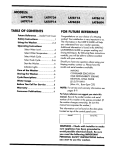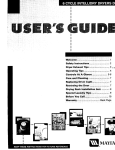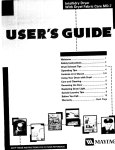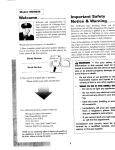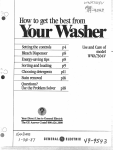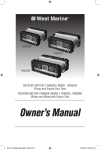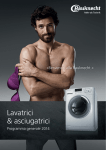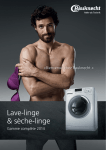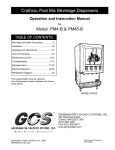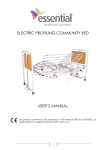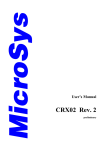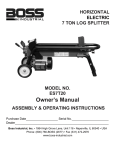Download Use & Care - Whirlpool
Transcript
JENN-AIR USE AND CARE MANUAL STACKED LAUNDRY CENTER MODELS LSE2704W, LSE2704W-C, LSG2704W BB ABOUT YOUR JENN-AIR Congratulations on your choice of a Jenn-Air stacked laundry center! Its unique design provides large full-size capacity in half the floor space of traditional side-by-side washers and dryers. As you use your new washer/dryer we know you will appreciate the many features that provide excellent cleaning and drying results, energy efficiency, convenience and dependability. On the following pages you will find a wealth of information regarding all aspects of your beautiful new laundering center. By foIlowing these instructions carefully, you will be able to achieve excellent results with your washer/dryer. --Do not store or use gasoline or other flammable vapors and liquids in the vicinity of this or any other appliance. --WHAT TO DO IF YOU SMELL GAS For future reference we suggest you retain this manual after recording the model number and serial number (six • Do not try to light any appliance. • DO not touch any electrical switch; do not use any phone in your building. numbers and two letters) of this automatic washer/dryer in the spaces provided below, • Clear the room, building or area of all occupants. • Immediately call your gas supplier from a neighbor's phone. Follow the This information can be found on the data plate located on the upper left corner of the dryer door recess. Model gas supplier's instructions. • If yOU cannot reach your gas supplier, caU the fire department. --Installation and service must be performed by a qualified installer, service agency or the gas supplier. Serial No. WARNING -- To reduce the risk of fire, electric shock, or injury to persons, read the IMPORTANT PERSONAL SAFETY INSTRUCTIONS page I before operating this appliance. on BB YOUR NEW JENN-AiR LAUNDRY CENTER The controls for the stacked washer and dryer are convenient and easy to use. The washer and the dryer can be run at the same time or either by itself, The following pages offer detailed instructions on how to use your new stacked washer and dryen The first section of the instruction book is for the washer (pp. 3-5), the last section is for the dryer (pp. 6-7). IMPORTANT PERSONAL SAFETY INSTRUCTIONS solids, should nor be placed in the appliance until all traces of these flammable liquids or solids and their fumes have been removed. There are many highly flammable acetone, denatured 1. Read all instructions Retain all instructions before using for future use. the appliance, 2. Installation-Install and locate this appliance ing to the Installation Instructions. chemical solvents, some liquid household cleaners, some spot removers, turpentine, waxes and wax removers. accordb. Do not add gasoline, dry-cleaning solvents, or other flammable or explosive substances to the wash water. These substances give off vapors that could ignite or explode. a. This appliance must be properly grounded. Never plug the appliance electric cord into a receptacle which has not been grounded adequately and in accordance with local and national codes, c. HYDROGEN GAS IS EXPLOSIVE. Under certain conditions, hydrogen gas may be produced in a hot water system that has not been used for 2 weeks or more. If the hot water system has not been used for such a period, before using a washing machine or combination washer-dryer, turn on all hot water faucets and let the water flow b. This appliance must be connected to a properly rated, protected, and sized power supply circuit, c. Do not install or store this appliance where it will be exposed to temperatures below freezing or exposed to the weather, d. This appliance must be connected plumbing and drain facilities, to adequate from each for several minutes. This will release any accumulated hydrogen gas. As the gas is 3. If someone should get an electrical shock from the appliance, disconnect the electrical power. DO NOT OPERATE until it has been repaired by an authorized Jenn-Air Service Contractor. 4. To prevent items used in homes, such as: alcohol, gasoline kerosene, oil, flammable, do not smoke or use an open flame during this time. d. Do not use heat to dry articles containing foam rubber (may be labeled latex foam), plastics or similarly textured rubber like materials. Foam rubber materials when heated, can under certain injury to children: a. Do not allow children to pay on, in, or with the appliance. Close supervision of children is neces- circumstances bustion. sary when using the appliance, b. Keep all laundry aids out of reach of children preferably in a locked cabinet. Use laundry aids only as directed by the manufacturer and observe all warnings on the container labels. produce fire by spontaneous corn- e. c. Destroy the carton and plastic bags after unpacking the appliance. Cartons covered with rugs, bedspreads, or plastic sheets can create a chamber with inadequate ventilation. d. Remove the door to the washing and drying compartment before the appliance is removed from f. Keep area around and underneath the appliance free from the accumulation of combustible materi- service or discarded, als such as lint, paper, rags, gasoline, flammable vapors and liquids. 5. g. Do not allow the ventilation a. Do not wash or dry articles that have been previously cleaned in, washed in, soaked in, or spotted with gasoline, dry-cleaning solvents, other flammable or explosive substances as they give off vapors that could ignite or explode. Any material on which you have used a cleaning solvent, or which is saturated with flammable liquids or and all other storage of any material to obstruct air opening of the dryer. h. To prevent extended drying time and risk of fire. CLEAN LINT SCREEN BEFORE EACH LOAD. i. The interior of the dryer should cleaned periodically tectmician. 1 and the exhaust duct by a qualified service mm IBBImm j. The exhaust system should be periodically examined for damage to the exhaust duct and for free operation of the exhaust deflector. Keep the area around the exhaust opening and surrounding areas free from the accumulation of lint, dust and dirt. k. For Gas Dryers: Gas dryers ate on natural gas only. To operation with other gases, ifled Jenn- Air Service obtained. are equipped to operconvert a gas dryer for the services of a qualContractor must be 6. Do not reach into the appliance dryer drum is moving. 7. Do not tamper d. After using these removers, thoroughly rinse the clothes by hand before they are placed in the washer. Some of the components and the finish of these removers - for example: rust remover - will damage the components and the finish of the washer. if the tub, agitator 15. Improper laundering of flame retardant finishes could remove them. Therefore, follow garment manufacturer's instructions carefully. or SAVE with controls. with a CSA Monogram on the data plate have been certified by the CSA Testing Laboratories as complying with Canadian Standards Association requirements. Gas dryers with an AGA symbol on the data plate have been design certified with the American Gas Association; those with a CGA symbol on the data plate have been approved by the Canadian Gas Association. damage to the appliance. 9. Keep pets away from dryer, and keep dryer door closed at all times except while loading or unloading, Pets may enter the dryer unnoticed when the door is open and become entrapped when the door is closed, 10. The agitator should not be removed. If the agitator is removed, it must be pushed down completely and the locking screw tightened before the washer is operated, Nevertheless, as with any equipment using electricity and having moving parts, there are potential hazards. To use this appliance safely, the operator should become familiar With the instructions for operation of the appliance and always exercise care when using it. 11. Do not use fabric softeners or products to eliminate static (unless recommended for use in clothes dryers by the manufacturer of the fabric softener or product). fiberglass articles unless Important Safety label states they are machine washable. Most fiberglass articles shed small particles of glass that will not readily rinse out of the washer. These particles may get on clothing in later loads and cause skin irritation and dis- The c. Use only BLE". products labeled Safe Drinking & Water Warning and Toxic Users of this appliance are hereby warned that the burning of gas can result in low-level exposure to some of the listed substances, including benzene, formaldehyde and soot, due primarily to the incomplete combustion of natural gas or liquid petroleum (LP) fuels. Exhaust ducts should be kept free of obstructions and properly exhaust- 14. Observe these precautions when using cleaning fluids, spot or stain removers, etc_: a. Use only according to the manufacturer's directions as stated on the label or carton, or in a well ventilated California Notice Enforcement Act of 1986 (Proposition 65) requires the Governor of California to publish a list of substances known to the State of California to cause cancer or reproductive harm, and requires businesses to warn customers of potential exposures to such substances. comfort. Be sure to rinse the washer thoroughly before using it again, 13. Do not dry fiberglass articles unless recommended by the manufacturer. b. Use outdoors INSTRUCTIONS Appliances with the @ symbol on the data plate have been listed with Underwriters' Laboratories, Inc. Those 8. Do not repair or replace any part of the appliance or attempt any servicing to prevent personal injury and 12. Do not wash THESE area. ed dryers "NON-FLAMMA- 2 will minimize exposure. PREPARING TO WASH 1. LIFT THE LID The washer lid lifts up and down to open and close. Internal springs will hold the lid in the open position until pulled down to close. 3. ADD DETERGENT You may use liquid or granular laundry detergent. Add a measured amount before loading. Read and follow the manufacturer's recommendations for using the correct amount. Most instructions are for washing an "average" load. If the degree of soil is heavier than average or the water is harder than 6 grains per gallon, more detergent should be used. Wipe up any spills of liquid laundry washer. Do not add detergent detergent to the fabric softener on the cup. 2. ADD BLEACH, if needed Undiluted liquid chlorine bleach may be added to the bleach dispenser as shown. Carefully measure the amount of bleach recommended on label of bleach bottle for the following number of gallons of water: SMALL - 11 gallons (9 Imperial gallons; 42 liters); MEDIUM - 13 gallons (11 Imperial gallons; 49 liters); LARGE - 16 gallons (13 Imperial gallons; 61 liters). Properly diluted bleach will be added automatically to the wash water, NOTE: 4. PLACE CLOTHES IN WASHER Be careful whenever you use liquid chlorine bleach. Do not pour directly on fabrics. Wipe up spills with a paper towel, Put dry, unfolded clothes loosely in the tub, up to the top row of holes for a maximum load. Do not pack or wrap items around the agitator. Be sure to empty all Oxygen bleach may be added by following the instructions on the package. Do not put powdered bleach or detergent in the bleach dispenser, pockets and mend any holes or tears. An overlooked pen, crayon, lipstick, eraser, knife, nail, or other similar objects being left in a pocket may result in per- NOTE: manent All bleaches, whether liquid or granular, are powerful chemicals and can cause fabric damage such as tears or color loss if not used properly. damage to the wash load. 5. ADD FABRIC SOFTENER, if desired Add the recommended amount to the cup in top of the agitator. The cup may be lifted out for easy filling. Add water to bring liquid level just below openings at the rim of the cup. Diluted fabric softener will automatically be added to the final rinse. (Always dilute fabric softener with warm water.) When using fabric softener, do not interrupt the spin following wash because the softener will go into the washbasket at the wrong time. Periodically clean the cup with hot water brush or cloth. 6. and a soft Close the lid and you are ready to set the controls. OPERATING THE WASHER CONTROLS 1. SELECT WATER LEVEL 2. SELECT WATER TEMPERATURE Water level is selected by turning the load size selecfor knob to the Small, Medium, or Large setting, HOT--Wash water will be the temperature of the water coming from the hot water faucet. Rinse water Remember, for best washing results, clothes must circulate freely. If too little water is used, poor cleaning, linting and excessive wear may result, will be cold. Use this setting for heavily soiled whites and colorfast items. The water heater should be set to a minimum of 120°F, with hotter water temps up to 140°F for best results. SMALL--Use this setting when tub is less than 1/2 full of clothes. Tub fills with 11 gallons (9 Imperial gallons; 42 liters), WARM--Wash water will be a mixture of water coming from the hot and cold water faucets. Rinse water MEDIUM--Use this setting when tub is from 1/2 to 3/4 full of clothes. Tub fills with 13 gallons (11 Imperial gallons; 49 liters), will be cold. Use this setting for delicates, items or permanent press garments with moderate soil. LARGE--Use this setting when tub is from 3/4 to full of clothes. Tub fills with 16 gallons (13 Imperial gallons; 61 liters). NOTE: When laundering permanent press items, delicates, washable woolens or loosely knit items, never use less than the MEDIUM setring. This will minimize shrinkage, wrinkling and pulling of seams. COLD--Wash and rinse water will be the temperature of the water coming from the cold water faucet. Use this setting to minimize fading of brightly colored items and shrinking of washable woolens. NOTE: Water below 65°F is too cold to dissolve and activate granular detergents. 4 colored light to 3. SELECT CYCLE AND TIME Push in the cycle the proper cycle For REGULAR control knob and wash FABRICS, and turn 4. START THE WASHER clockwise to time. turn the control knob to 6- Pull out the cycle will fill to the wash water control selected temperature. knob water to start level After filling, 10 minutes for normally soiled loads; up to 12 minutes for more heavily soiled loads; and less than 6 minutes for lightly soiled loads, for the selected number of minutes. The washer will pause briefly cycle. These pauses are normal. For PERMANENT knob at 6-8 minutes This washer is designed or spin when the lid PRESS loads, set for normally soiled press items; up to 10 soiled permanent press utes for lightly soiled NENT PRESS cycle can nent press items when the control permanent minutes for more heavily items; and less than 6 minitems. NOTE: This PERMAalso be used for non-perma- additional rinsing the washer. the It selected it will agitate throughout each so that it will not fill, agitate is open. Should the lid be opened during a cycle, the washer will stop; when the lid is closed and the control knob is pulled out, the washer will resume its cycle at the point it was interrupted. is needed. NOTE: For DELICATE loads (garments of delicate construction, sheer fabrics, lace trimmed and embroidered items, lingerie, washable woolens, and "handwashable" items), set the control knob at start. The washer will fill, then agitate and soak alternately, and proceed through the rinse and final spin. See below for cycle with If an unbalanced load occurs during the spin, the washer will automatically stop. If this happens, push in the knob, open the lid, redistribute the load, close the lid and pull out the control knob. description. CYCLE DESCRIPTION TOTAL WATER REGULAR FABRICS PERMANENT PRESS DELICATE FABRICS Regular or Delicate Cycle USAGE Permanent Press Cycle Pill WASH SPIN&DRAIN Pill Fill WASH WASH SPIN&PARTIAL DRAIN SOAK SMALL ................... Approx. 24 gallons ............ Approx. 30 gallons (20 Imperial gallons) (25 Imperial gallons) (91 liters) (114 liters) SPRAYRINSE SPIN&DRAIN Fillwithcoldwater AGITATE MEDIUM Pill SPIN&DRAIN DEEPRINSE&AGITATE Fillwithcoldwater WASH SOAK WASH SPIN&DRAIN SPIN&DRAIN DEEPRINSE&AGITATE SPRAYRINSE SPRAYRINSE FINALSPIN SPIN&DRAIN SPRAYRINSE SPIN&DRAIN Fill FINALSPIN DEEPRINSE&AGITATE SPIN&DRAIN .............. Approx. 30 gallons ............ Approx. 40 gallons (25 Imperial gallons) (33 Imperial gallons) LARGE ................... Approx. (114 liters) (151 liters) 36 gallons ............ Approx. 50 gallons (30 Imperial gallons) (136 liters) SPRAYRINSE FINALSPIN 5 (42 Imperial gallons) (189 liters) PREPARING TO DRY 1. CHECK THE LINT FILTER Clean the hnt filter after each load. It's best to check this when the dryer is empty to prevent falling onto items inside the dryer. lint from To clean, pull the filter out and remove any lint. (See illustration at right.) Failure to clean the filter will cause loads to take longer to dry and make the dryer operate less efficiently. Replace the filter by pressing NOTE: Do not operate filter in place. it firmly into position. the dryer without the lint While the lint filter will catch practically all of the lint from the clothes, some fine lint dust will get through and may build up in the exhaust ducting. It is important that the ducting be cleaned out with a vacuum cleaner every year to maintain efficient drying. The hinged cover in the hood at the outside end of the exhaust duct should be cleaned more frequently to keep it free to open and close. 2. LOAD THE DRYER A proper washer load is a proper dryer load. Do not combine loads. Avoid drying very small loads or mixed loads of heavy, hard-to-dry items and lightweight ones. Normal sized loads dry most efficiently. (A full load is shown below.) NOTE: If you are using ener, it should a dryer-added fabric softbe added with the load before starting the dryer. Adding one after the load is warm can cause greasy-looking softener stains. 6 OPERATING THE DRYER CONTROLS approximately 5 minutes momentary buzzer. I 1. SELECT ,i down and a WRINKLE RELEASE -- Found in the Time Dry portion of the dial, use this cycle to release wrinkles from items that are clean and dry but slightly wrinkled from a crowded closet or suitcase or from sitting in the dryer after the cycle is complete. It provides 10 minutes of heated tumbling and 5 minutes of cool down. _H_ DRYING of cool DAMP DRY -- To partially dry items to a damp state, select "damp dry" on the Time Dry portion of the controls. The clothes will tumble in heated air for 20 minutes, then cool air for 5 minutes. TEMPERATURE Turn the temperature selector knob to the proper drying temperature. The choices are: AIR FLUFF -- Turn the cycle selector dial to the AIR FLUFF portion for the desired number of minutes. REGULAR -- Use this setting for drying sturdy cottons or regular garments and those items labeled "Tumble Dry," etc. This provides tumbling without heat. 3. PUSH THE BUTTON TO START DELICATEUse this setting for drying those heatsensitive items labeled "Tumble Dry Low," "Tumble Dry Warm," etc. This dryer is designed so that it when the door is open. If the door the cycle is complete, the door must start button pushed again to restart 2. SELECT THE CYCLE will not operate is opened before be closed and the the dryer. 4. REMOVE LOAD IMMEDIATELY The Electronic Dry Control cycles include Regular Fabrics and Permanent Press. These cycles provide automatic sensing of the moisture amount in the load and shut off when the selected dryness is reached. The time required to reach that dryness will vary for each load according to the size of the load, the weight of the fabric, length of venting, etc. For these cycles, At the completion of any cycle, a buzzer will sound momentarily to let you know the dryer has shut off. On the Permanent Press cycle, the buzzer will sound after the normal cool-down period to let you know Press Care tumbling has begun and the load can be removed at any time. 5. turn the cycle control to the desired start position. The Time Dry cycle does not sense the moisture, but rather, dries items by setting a desired time on the controls, DRYER ENERGY SAVING TIPS • Clean the lint filter after each cycle for greater ciency and performance. effi- REGULAR FABRICS -- Use this cycle for non-permanent press loads such as towels, underwear, etc. At the end of the cycle there is an automatic cool down of approximately 7 minutes and a momentary buzzer. • Avoid overloading the dryer. Aproper wash load is a proper dryer load. Do not combine loads. Avoid drying very small loads or mixed loads of heavy, hard-to-dry items with lightweight ones. • Properly select and check exhaust venting. Four PERMANENT PRESS -- Use this cycle for permanent press loads or no-iron fabrics such as nylon, acrylic, polyester or blends. At the end of the cycle there is an automatic cool down of approximately 30 minutes to minimize wrinkling. The buzzer will sound once or twice during the cool down to let you know the cycle is nearly over and again when the dryer turns off. inch rigid metal ducting is recommended to prevent lint collection and improve dryer operation. Periodically check the ductwork for any obstructions that could reduce the airflow and efficiency. • Remove items from the dryer as soon as tumbling stops for best results and efficiency. This reduces wrinkling and ironing. TIME DRY -- This cycle may be used for any load when Electronic Dry is not preferred. Set the dial to the amount of time desired. This will be followed by 7 INSTALLATION AND MAINTENANCE EXHAUSTING THE DRYER DRYERTUMBLERCARE A proper exhaust system is critical for good drying results. Restricted airflow affects dryer performance and results in longer drying times. Exhaust ductwork guidelines: If the tumbler becomes stained by a crayon, ink pen or other item inadvertently left in a garment, clean the turnbler with an all purpose cleaner such as: Fantastik, Soft Scrub or Formula 409®. * Then tumble old towels or rags to remove any excess stain. • Use 4" diameter rigid metal exhaust duct. Do not use smaller duct. Minimize the length of duct and the number of elbows. Secure joints with duct tape. Do not use DRYER EXHAUST SYSTEM CLEAN I NG screws, • Never use plastic or nonmetal flexible duct. This can kink, cause lint buildup and reduce airflow which creates service problems, • If flexible duct must be used, use only the type with a stiff sheet metal wall. Do not kink or crush the duct. Do not use flexible duct with a thin foil wall. • Clean out previously used exhaust duct. Replace kinked or crushed sections. Be sure exhaust vent hood While the lint tilter will catch practically all of the lint from the load, some fine lint dust will get through and may build up in the venting. It is important that the venting be cleaned out every year to maintain efficient drying. The hinged cover in the hood at the outside of the home should be cleaned more frequently to keep it free to open and close. Refer to the Installation proper Instructions for more details on venting. flap opens and closes freely. • Refer to the installation instructions STORING for additional FOR WASHER THE AND STACKED Washers DRYER use any abrasive panel with a soft damp powders or cleaning WASHER can be damaged if water is not removed hoses and internal components before storage. the washer and dryer for storage as follows: CONTROL PANEL CARE Clean the control STACKED AND DRYER dryerexhaustinformation. CARING THE pads. CABINET CARE • Turn the water hoses. water, Prepare • Select the Regular Fabrics cycle and add one cup of bleach or white vinegar to a full load of warm or hot water without clothes. Run the washer through a complete cycle. cloth. Do not Simply wipe off any marks with soap and lowed with an appliance wax if desired. from faucets off and disconnect the inlet fol- WASHER LINT FILTER CARE • Advance the cycle control knob to the final spin of the Regular Fabrics cycle and drain any water that may be in the drain hose. The lint filter is located in the center of the agitator. After each use, take the lint filter out of the agitator and clean any lint off the screen. Because of the effectiveness of the draining system, normally there will be little or no lint on the filter. More lint will be collected when washing very linty loads, such as terrycloth towels, throw rugs or blan- • Disconnect the washer and dryer from the electrical supply and leave the washer lid open to let air circulate inside the tub. • Clean the dryer tumbler with an all purpose cleaner such as Fantastik or Formula 409 ®* and disconnect from the power supply. kets. *Brand names are trademarks of the respective manufacturers. 8 n BEFORE YOU CALL FOR SERVICE, CHECK THESE POINTS... IF YOUR WASHER: WON'T FILL WON'T AGITATE X WON'T SPIN OR DRAIN X X STOPS LEAKS WATER WATER TEME IS INCORRECT IS NOISY X X X REASON -- DO THIS TO CORRECT Plug cord into electrical outlet. Check fuse or reset circuit breaker. Set selector to proper cycle and pull knob out to on position. X X X POSSIBLE Turn both faucets on fully. X X Straighten hoses. Eliminate kinked drain restriction, call for service. X X Close lid and pull knob. X X Off-balanced load. Redistribute clothes evenly, close lid and pull knob. Check for leveling. Be sure water fill is acceptable for load size. X hoses. If there is a X Make sure hose connections X Make sure end of drain hose is correctly and secured to drain facility. are tight at faucets. inserted This may be a pause or soak period. Wait several minutes and it may start again. Make sure washer is level and firm to the floor. X X Make sure temperature selector is correctly set. Make sure hoses are connected to correct faucets and inlet X connections. Be sure water supply is regulated rectly-. Flush water line before filling washer. X X X minimum of 120°F hot water at the tap. Also check water heater capacity and recovery rate. X Hose filter screens dean screens. plugged. Disconnect hoses and DRYER: DOES NOT RUN DOES NOT HEAT DOESN'T DRY CLOTHES PROPERLY IS NOISY X POSSIBLE REASON • Opening the door during be pushed -- DO THIS TO CORRECT operation after closing the door stops the dryer. The start button to restart X • Be sure cord is plugged into a live electrical not loose. • Check fuse or reset circuit breaken X X X • Close dryer dial. X X • Be sure dryer is set for a heat setting and not air-fluff. • If you have a gas dryer, check to see that the gas valve is turned up. • Clean lint screen and be sure exhaust duct to outside is not blocked. • Be sure dryer load. X ON GAS DRYERS: is not overloaded. outlet and the connection cycle and time, then press start button One washer load should is or equal one dryer • For time dry, be sure you have selected the proper time for load. For electronic dry, adjust dryness control to more, normal or less dry setting. • Exhaust duct is too long, too small, or has more than 2 bends or is made of plastic flexible material. Replace with metal. • Heavy garments were not sorted from lightweight garments. • Washer spin cycle may not be extractin8 water properl_ X NOTE door, set for proper must the dryer. X SPECIAL cor- Suds lock -- caused by too much suds. Rewash with out detergent. Use correct amount of low sudsing detergent. Check the water heater. It should be set to deliver a X X IF YOUR in • Check to see if there are any foreign objects such as coins, buttons, or nails which could damage clothes as well as the dryer. Remove promptly. Fumes from products such as paints, varnishes, waxes, etc., can be pulled A gas-like odor in the load will result until the fumes diminish. 9 into the dryer when operating. JENN-AIR FULL-SIZE STACKED WASHER AND DRYER WARRANTY FULL ONE YEAR WARRANTY For one (1) year from the date of original replaced free of charge. purchase, any part which fails in normal home use will be repaired or LIMITED PARTS WARRANTY After the first year from the date of original purchase, through the time periods listed below, the designated parts which fail in normal home use will be repaired or replaced free of charge for the part itself with the owner paying all other costs, including labor. SECOND YEAR - All Parts. THIRD YEAR THROUGH ADDITIONAL TENTH YEAR - All Parts of the Transmission LIMITED WARRANTY Assembly. AGAINST RUST Should any of the parts listed below rust during the one year period starting from the date of original purchase, repair or replacement will be made free of charge. After the first and through the fifth year, repair or replacement will be made free of charge for the part itself, with the owner paying all other costs, including labon Parts covered by this warranty are: AUTOMATIC WASHER: DRYER: Exterior Exterior Cabinet, Top, Lid, and Baseframe. Cabinet, Top, Door, Clothes Tumbler, Tumbler Front, Tumbler Back and Stand. This full warranty and the lirrfited warranties apply when the appliance is located in the United States or Canada. Appliances located elsewhere are covered by the limited warranties only, which includes parts which fail during the first year. OWNER'S RESPONSIBILITIES accordance with the Use & Care instructions, sonably accessible for service. include proper installation, providing normal care and maintenance in providing proof of purchase on request, and making the appliance rea- WARRANTY SERVICE; Under the full warranty, service must be performed by an Authorized Jenn-Air Service Contractor. To obtain service, contact the dealer from whom the unit was purchased, an authorized service contractor, or contact Jenn-Air Customer Assistance, c/o Maytag Customer Service, P.O. 2370, Cleveland, TN 373202370, 1-800-688-1100 (United States and Ontario) or 1-615-472-3333. Please include model number, serial number, and date of original purchase in all correspondence. Service will be provided ment parts assume the unused portion of this warranty. This warranty during normal business hours. All replace- gives you specific legal rights, and you may also have other rights which vary from state to state. __C JENN-AIR 0 M P A N Y 3035 SHADELAND • INDIANAPOLIS, INDIANA46226-0901 Should you still have a problem, Illinois 60606. write to: Major Appliance MACAP is an industry appliance owners. but independent NOTE: sponsored When writing about an unsolved group service problem, of consumer Your name, address, (b) Model number (c) Name and address of your dealer and date the appliance (d) A clear description of the problem Catalog No LU2704UB and serial number Action Panel, 20 North Wacker Drive, Chicago, experts please include (a) Part No. 3-157660 and telephone Consumer who receive and act on complaints the following from information: number; (found on upper left comer of the dryer door recess) of your appliance; was bought; you are having. Printedin U.S.A. 7/95












